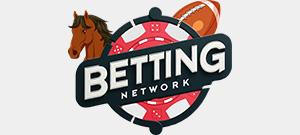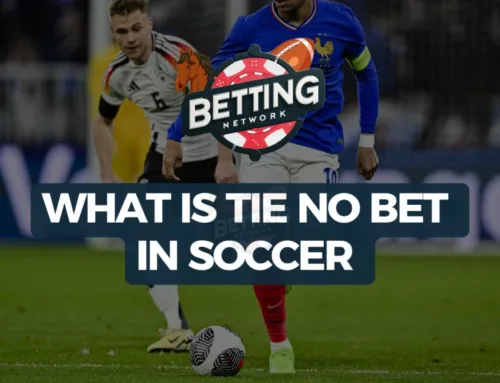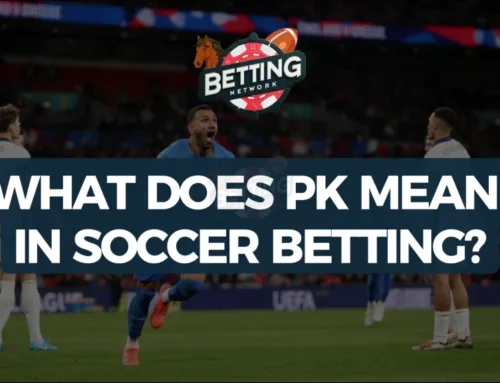We’re about to explain what does -1 mean on every relevant soccer bet we can find. The fastest way to explain the concept of course and all the differences between each type. This is a long one but if you want to get this bet down to a T, it’ll be worth it!
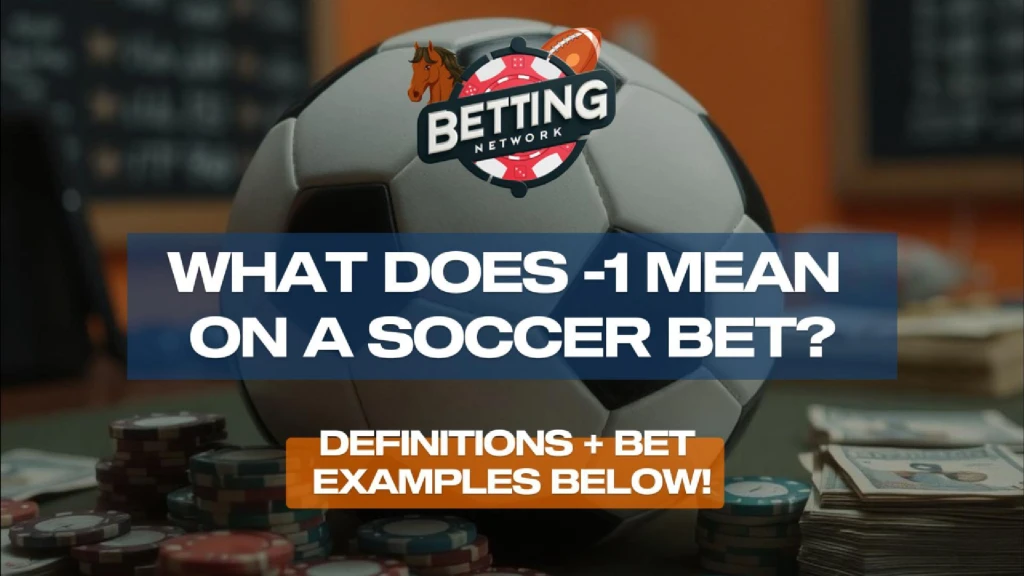
What Does -1 Mean on a Soccer Bet?
Let’s explain what does -1 mean on every relevant soccer bet we can find. The fastest way to explain this concept and all the differences between each type of bet is by using an example of a soccer match.
First things first: When you see a -1 on a soccer bet, it means the favored team needs to win by more than one goal for you to win your bet. Essentially, you’re giving the underdog a one-goal head start.
So, imagine Italy is playing Albania. The bet looks like this: Italy -1
As you might’ve guessed already, this handicap betting basically balances the scale when one team is much stronger than the other in order to keep the bet interesting.
Understanding Handicap Odds in Soccer
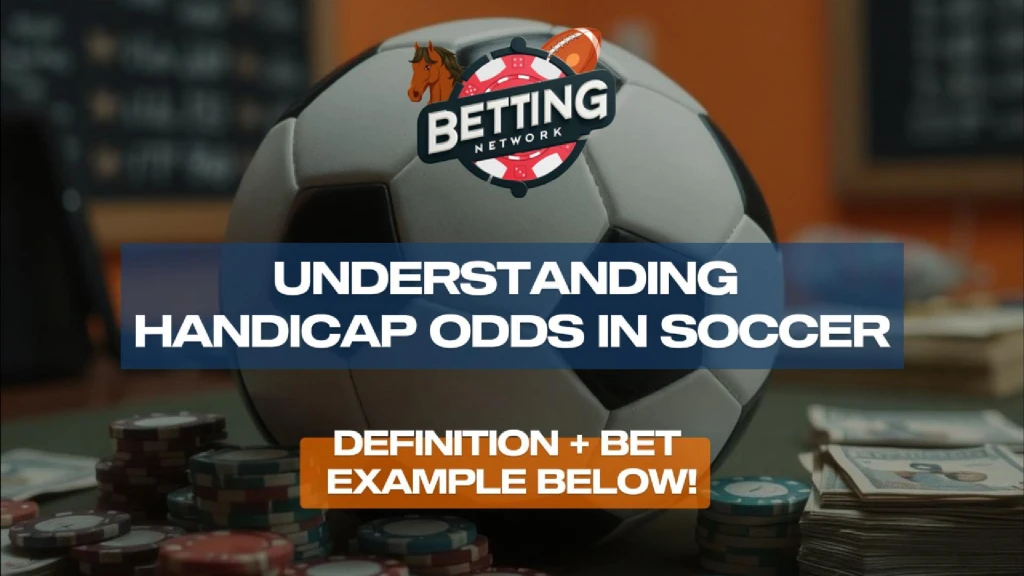
Since we’re talking about handicap betting (also known as spread betting), we might as well touch on these types of bets too.
In handicap betting, the stronger team is given a virtual disadvantage, and the weaker team gets a virtual advantage. This makes betting more interesting and balanced and it’s also where American Odds come into play:
The odds are crucial in sports betting because they determine how much money you can win. As I mentioned at the start, in American odds, you’ll see numbers with either a minus sign (-) or a plus sign (+). They’re based on a $100 bet, but you don’t need to bet that much to understand how it works.
- Minus Sign (-): Indicates the favorite. It shows how much you need to bet to win $100.
- Plus Sign (+): Indicates the underdog. It shows how much you can win if you bet $100.
We also go in great detail about handicap betting for MLS Soccer Bets in case you’re interested in league examples instead of international matches.
What if you Bet Less Than $100?
Theres no issue whatsoever. Your winnings will be a fraction of the $100 odds.
- For instance, if you bet $50 on Ukraine at +500 and they win, you’d get $250 in profit (since $50 is half of $100, and half of $500 is $250).
What Does -1 Mean on Moneyline Bets
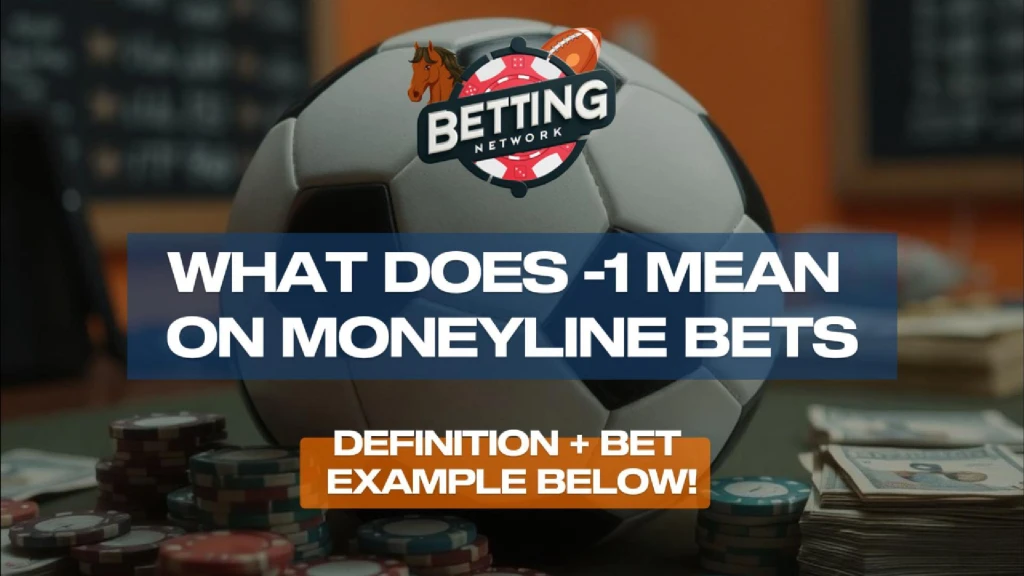
Let’s explain what -1 means on moneyline bets using another example: an England vs Poland match.
When you see a -1 on a moneyline bet, it means you’re betting on the favorite (England in this case) to win by more than one goal. It’s like England starts the match with a one-goal disadvantage.
What if you see a -120 on a moneyline bet for that same match?
It means you need to bet $120 to win $100. This negative number indicates that England is the favorite to win the match, so the bookmarker sets this number to balance the action between both sides.
So, let’s say that, with the rates set by the sportsbook I bet $120 on England. They got Bellingham, Foden and many other Premier League stars, so I’m confident about my bet.
- If they win, I get my $120 back and cool $100 in winnings, totaling $220. Not bad.
- However, if England loses the match or draws, I lose my $120 bet. England has fumbled some games in spectacular fashion, so this isn’t impossible by any stretch of the imagination.
Overall, it keeps things interesting and gives a chance for those that bet on the underdog to win big.
What Does -1 Mean on Point Spread Bets
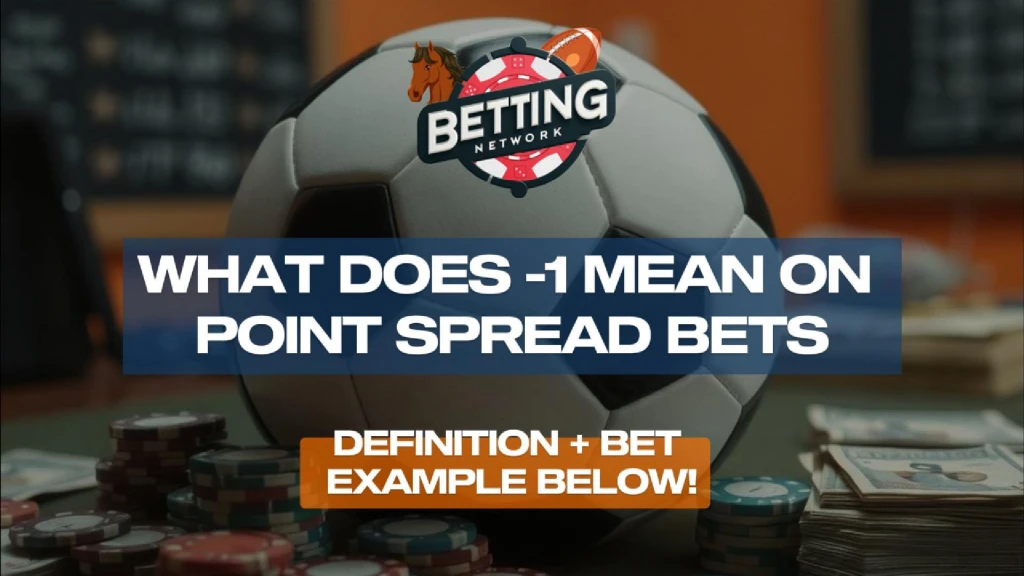
Let’s use our England vs Poland example to see what does -1 mean on point spread bets in soccer.
When you see -1 on a point spread bet, it means England (the favorite) needs to win by more than 1 goal for you to win your bet. Essentially, England starts the game with a 1-goal disadvantage.
Once again:
- If England wins by 2 or more goals (like 2-0 or 3-1), you win the bet.
- If England wins by exactly 1 goal (like 1-0 or 2-1), the bet is a push, and you get your money back.
- If the game ends in a draw or Poland wins, you lose the bet.
Now, let’s add the -120 part to the point spread bet. When you see -120, it indicates the amount you need to risk to win $100.
What Does -1 Mean on Over/Under (also known as Totals) Bets
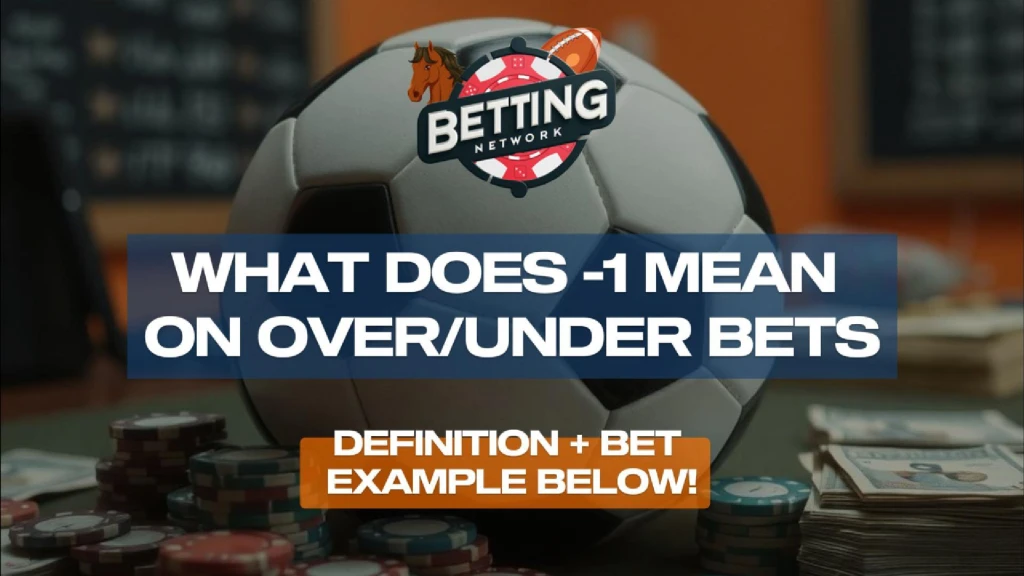
First off, an Over/Under bet is where you wager on the total number of goals scored in a match by both teams combined. The bookmaker sets a specific number, and you bet whether the actual total will be over or under that number.
So, What Does -1 Mean on Over/Under Bets?
In this context, the -1 doesn’t directly apply to the Over/Under itself but rather to the odds associated with the bet. The number -1 is not typically used to describe Over/Under lines. Instead, Over/Under bets are usually expressed as a number of goals, such as 2.5, 3, or 3.5.
However, if we are talking about odds like -110, -120, etc., here’s how they apply:
In summary, the -1 isn’t directly applicable to Over/Under lines but the odds attached to these bets, like -120, tell you how much you need to risk to win $100.
- The Over/Under bet itself is about predicting whether the total goals scored will be over or under the set number. They’re two different parts of the same puzzle for this bet.
What Does -1 Mean on Prop Bets
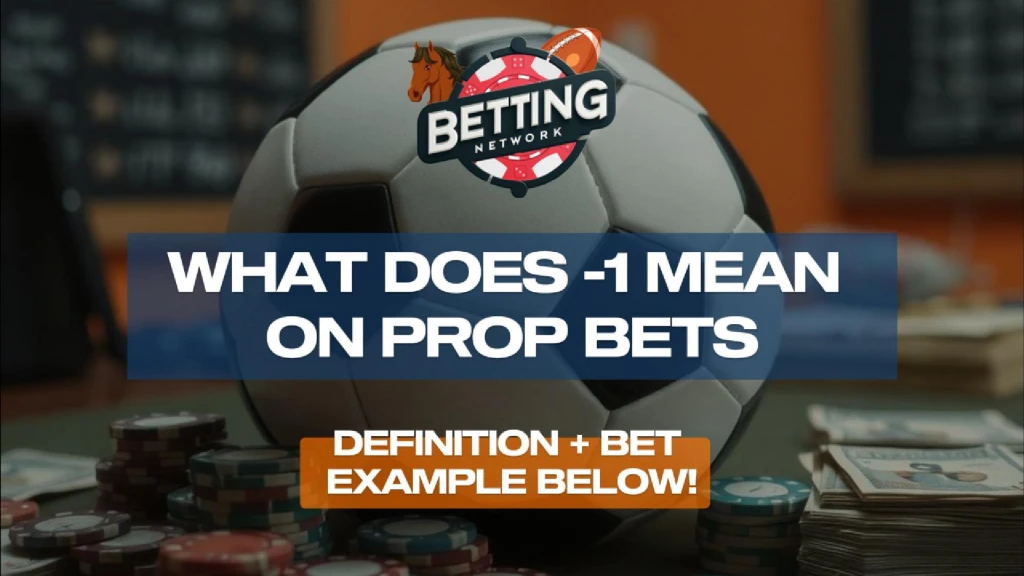
This time let’s break down what -1 means on prop bets for the same scenario (a match between England and Poland):
- Prop bets, or proposition bets, are wagers on specific events within a game that don’t necessarily affect the final outcome. These can include bets on player performances, specific occurrences, or other game-related events.
So, when you see -1 on a prop bet, it usually refers to the odds rather than a handicap. This indicates that you need to bet a certain amount to win $100.
Let’s say there’s a prop bet on the number of goals Harry Kane will score in the match:
Harry Kane to score at least 1 goal: -1
- In this case, the -1 indicates that if Harry Kane scores at least one goal, you win the bet. However, the bet isn’t usually just listed as -1; it will often come with specific odds like -110 or -120. Here’s a more realistic scenario:
Let’s say that the odds for Harry Kane to score at least one goal are -120. This means you need to bet $120 to win $100.
Some Bet Examples:
You bet $120 on Harry Kane to score at least one goal with odds of -120.
- If Harry Kane scores at least one goal, you win the bet. You get your $120 back plus $100 in winnings, totaling $220.
- If Harry Kane doesn’t score, you lose your $120 bet. And, unless you’re betting on a league match, this will happen. A lot.
Another Example: Prop Bet on Corner Kicks
Let’s say there’s a prop bet on the total number of corner kicks in the match being over 10:
Total Corner Kicks Over 10: -1
Again, the -1 would generally indicate the odds. Suppose the odds for this bet are -110.
So, you place a $110 bet on Over 10 Corner Kicks with odds of -110.
- If there are 11 or more corner kicks in the match, you win the bet. You get your $110 back plus $100 in winnings, totaling $210. This is the kind of bet you’d make for a Manchester City game.
- However, if there are 10 or fewer corner kicks, you lose your $110 bet. Ouch.
What Does -1 Mean on Futures Bets
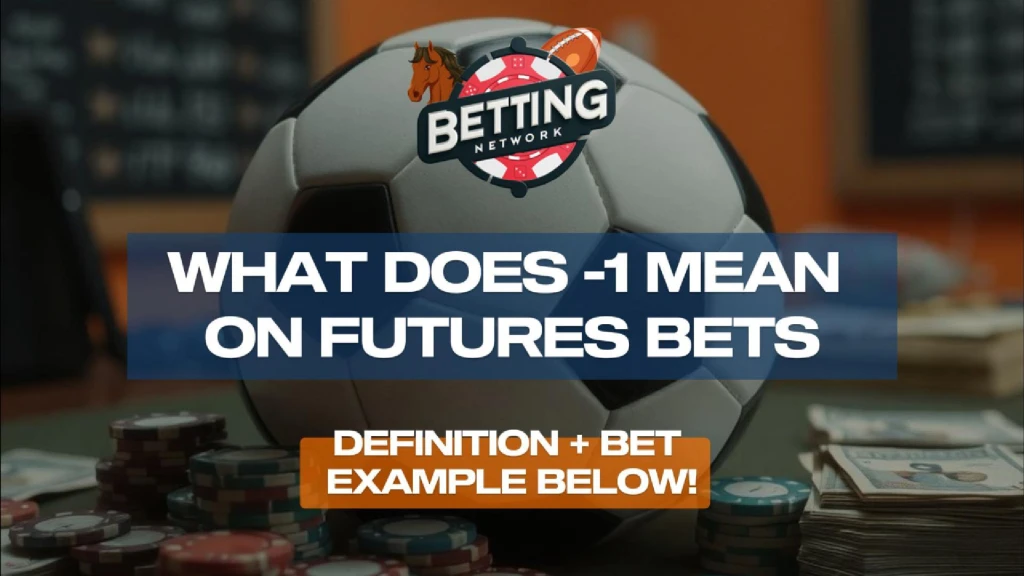
Future bets are basically wagers placed on things that will happen in the future, like which team will win a tournament, championship or league. You place these bets well in advance of the outcome.
-1 on future bets focuses on the odds associated with the bet, rather than a point spread. This is easier explained with an example too:
Let’s say you’re betting on who will win the UEFA European Championship. The odds might look like this:
- England to win the Championship: -1
- Poland to win the Championship: +400
-1 refers to the odds associated with the bet, not the point spread. The -1 indicates the amount you need to bet to win a certain amount of money (usually $100).
- This means that, you’ll mostly see it as -120, -150 rather than -1.
Let’s apply -120 odds to a futures bet. This means, in plain English, you’ll need to bet $120 to win $100.
- If you bet $100 on Poland winning the Euros, you’d score a $500 Jackpot (your $100 and an extra $400).
What Does -1 Mean on Parlay Bets

First and foremost, a parlay bet combines multiple individual bets into one larger bet. To win a parlay, all individual bets (usually called “legs”) within it must win.
If even one leg loses, the entire parlay bet loses. Obviously, parlays can offer higher payouts because they are riskier.
So, What Does -1 Mean on Parlay Bets?
When you see -1 on a parlay bet, it usually refers to the point spread for one of the legs in the parlay. It means the favored team must win by more than one goal.
- Let’s say you create a parlay bet involving two matches (including our usual England vs Poland match)
England vs. Poland - France vs. Germany
Lets say you bet on:
- England -1 (point spread)
- France moneyline (France to win)
What does England’s -1 mean?
- If England wins by 2 or more goals (like 2-0 or 3-1), this leg wins.
- If England wins by exactly 1 goal (like 1-0 or 2-1), this leg is a push, and the parlay reduces to the other bets.
- If England draws or loses, this leg loses, and the entire parlay bet loses.
What Does -1 Mean on Asian Handicap Bets
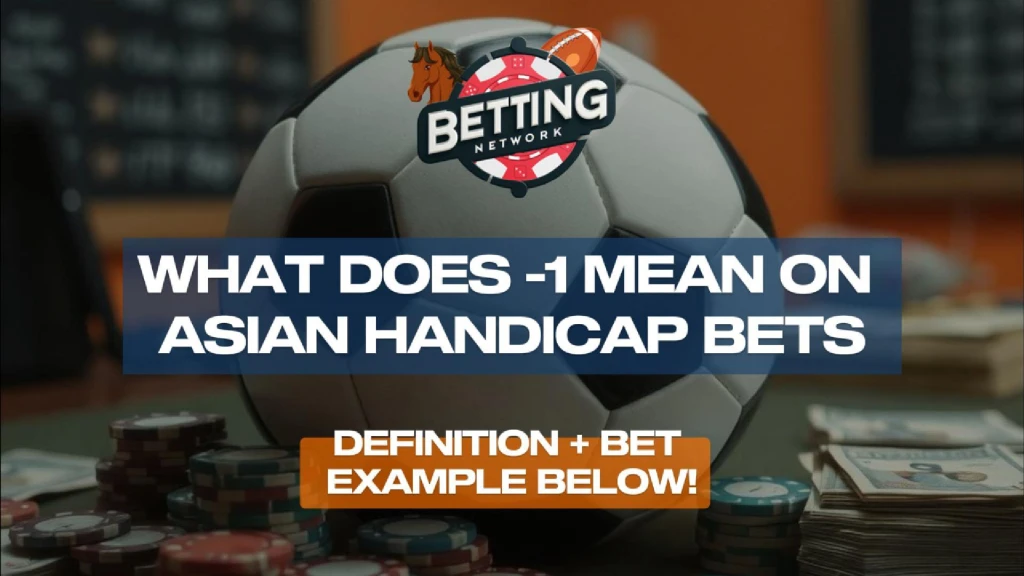
A quick recap on Asian Handicap: this type of spread betting does not offer draw as a possibility and it offers one team an advantage (or disadvantage) to level the playing field. This adds a layer of excitement and complexity to the bet.
Let’s use the England vs Poland example for consistency’s sake.
A -1 on an Asian Handicap bet means the team with the advantage (England) must win by more than one goal for you to win the bet. If they win by exactly one goal, the bet is a push and your get your money back. If England draws or loses, you lose your money.
Example Scenario:
Let’s say you bet on England -1 against Poland.
Possible Outcomes:
England wins by 2 or more goals (e.g., 2-0, 3-1):
- You win the bet.
- Your payout includes your stake plus winnings based on the odds.
England wins by exactly 1 goal (e.g., 1-0, 2-1):
- The bet is a push.
- You get your initial stake back, but no profit.
England draws or loses (e.g., 1-1, 0-1):
- You lose the bet.
- You lose your stake.
Bet Example:
Bet: $100 on England -1
Odds: -110
If England wins 2-0:
- You win your bet.
- You get your $100 stake back plus $90.91 in winnings (since -110 means you bet $110 to win $100, so $100/1.1 = $90.91).
- Total payout: $190.91
If England wins 1-0:
- The bet is a push.
- You get your $100 stake back.
If the match ends 1-1 or Poland wins:
- You lose your $100 bet.
What Does -1 Mean on European Handicap Bets
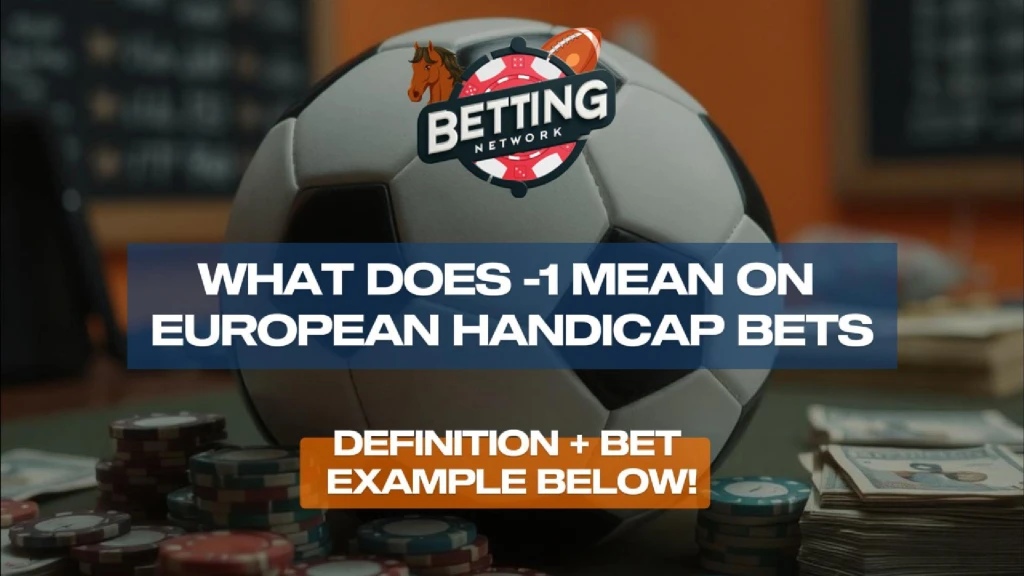
Let’s start by know how European Handicap bets work: these best involve giving one team a virtual advantage or disadvantage to even the playing field. Unlike Asian Handicaps, European Handicaps can result in three outcomes: win, lose, or draw.
When you see -1 on a European Handicap bet, it means the favored team (England, in this case) starts the game with a one-goal disadvantage. To win your bet, England must win by more than one goal. If they win by exactly one goal, the bet results in a draw. If they draw or lose, you lose the bet.
Example:
Let’s say you bet on England -1 against Poland.
Possible Outcomes:
England wins by 2 or more goals (e.g., 2-0, 3-1):
- You win the bet.
- Your payout includes your stake plus winnings based on the odds.
England wins by exactly 1 goal (e.g., 1-0, 2-1):
- The bet is a draw.
- You neither win nor lose your stake.
England draws or loses (e.g., 1-1, 0-1):
- You lose the bet.
- You lose your stake.
Bet Example:
Bet: $100 on England -1
Odds: +150
If England wins 2-0:
- You win your bet.
- You get your $100 stake back plus $150 in winnings.
Total payout: $250
If England wins 1-0:
- The bet is a draw.
- You neither win nor lose; your $100 stake is returned.
If the match ends 1-1 or Poland wins:
- You lose your $100 bet.
What Does -1 Mean on Both Teams to Score (BTTS) Bets
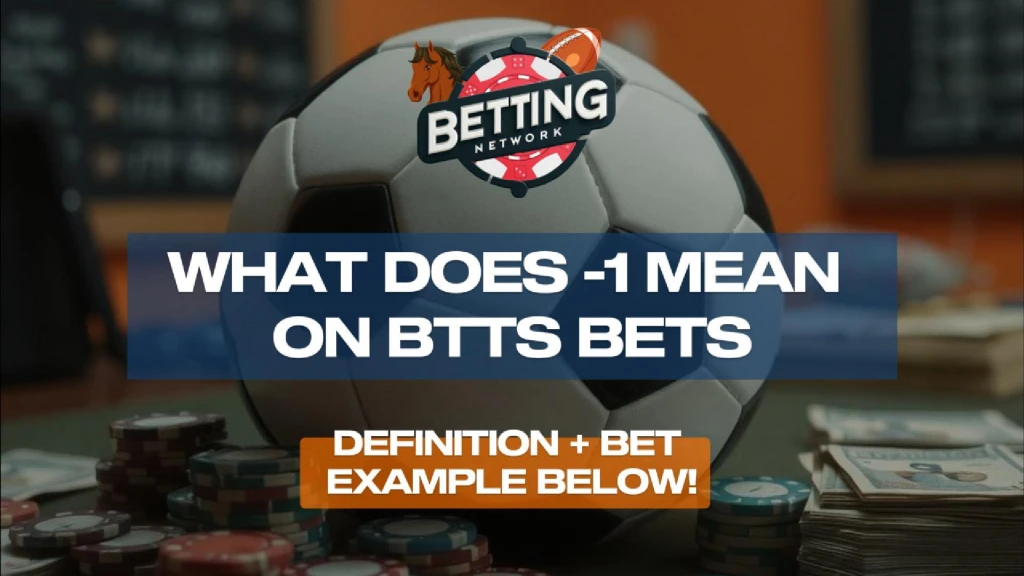
Ok so let’s play out our bet example for a BTTS bet. When you see -1 in the context of a BTTS bet, it usually refers to the odds, not the actual scoring. The number indicates how much you need to bet to win a certain amount. For example, -1 is shorthand for -110, -120, etc., which is more common.
Let’s run this type of bet for England vs. Poland to grasp the odds:
BTTS Yes: -120
BTTS No: +110
Meaning:
- BTTS Yes -120: You need to bet $120 to win $100 if you believe both teams will score.
- BTTS No +110: You need to bet $100 to win $110 if you believe at least one team will not score.
What Does -1 Mean on Correct Score Bets
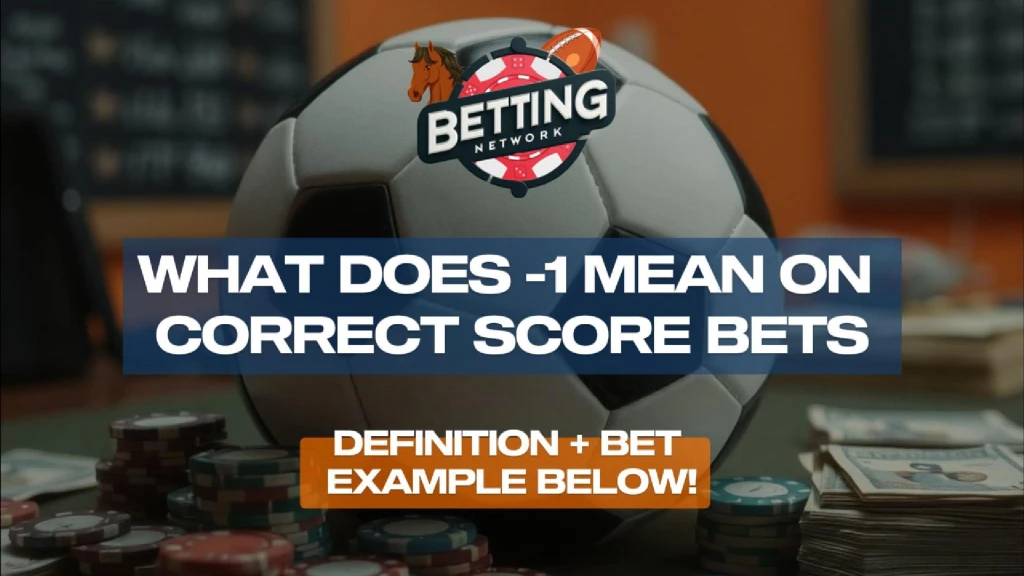
So first off, correct score bets involve predicting the exact final score of a match. No room for error here, so these bets are typically high-risk but can offer significant payouts because they are difficult to get right. The payouts are good enough to lure anyone in, so be sure to gamble responsibly too.
When you see a -1 in the context of correct score bets, it usually refers to the odds rather than the score itself. The number indicates how much you need to bet to win a certain amount. In reality that -1 would actually be more like a -110, -120, etc.
Once again let’s go back to our England vs Poland scenario:
Say you want to place a correct score bet on England vs. Poland, and you see the following odds:
England 2-1 Poland: -120
What this means again:
- You need to bet $120 to win $100 if you believe the match will end with England winning 2-1.
What Does -1 Mean on First Goal Scorer Bets?
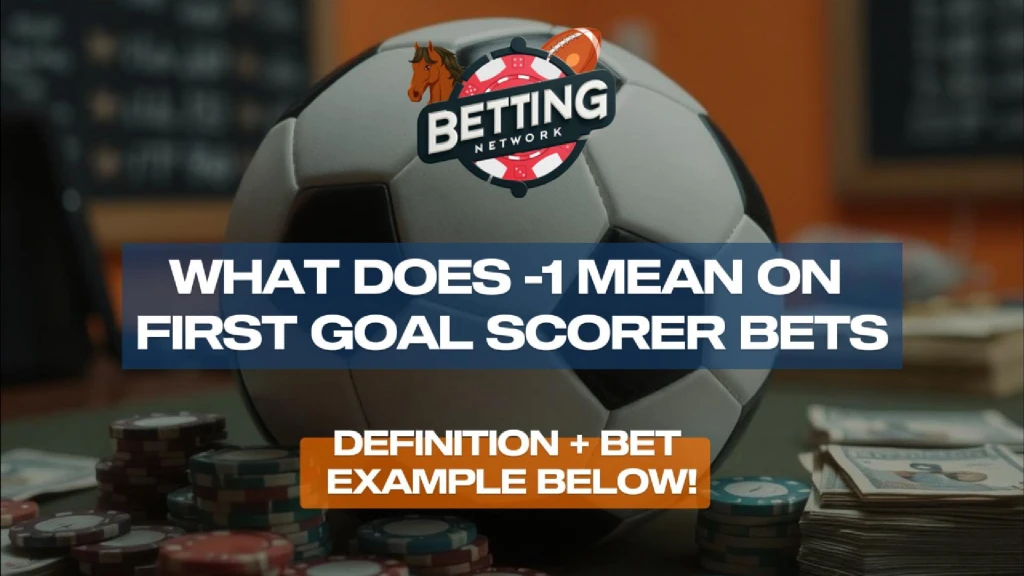
Let’s now break down what -1 means on first goal scorer bets using the same match (England and Poland) to get a hold of this bet:
First goal scorer bets involve wagering on which player will score the first goal in a match. These bets are very popular because they offer potentially big payouts if you pick the correct player.
When you see -1 it usually refers to the odds rather than a handicap. The number indicates how much you need to bet to win a certain amount. Once again for example, -1 would typically be expressed as -120, -150, etc.
Let’s say you want to place a first goal scorer bet on the England vs. Poland match, and you see the following odds:
- Harry Kane to score first: -120
- Robert Lewandowski to score first: +200
What does each means?
- Harry Kane -120: You need to bet $120 to win $100 if you believe Harry Kane will score the first goal.
- Robert Lewandowski +200: You need to bet $100 to win $200 if you believe Robert Lewandowski will score the first goal.
FAQs on Soccer Handicap Betting
What Does -1 Mean in Soccer Betting?
A -1 handicap means the favored team must win by more than one goal for the bet to succeed. If the team wins by exactly one goal, the bet is a push, and the stake is refunded. If the team draws or loses, the bet is lost.
Is Betting on Handicaps Profitable?
Betting on handicaps can be profitable if you know the team’s strengths, weaknesses, performance and lineups with in-depth.
What Should I Consider Before Placing a Handicap Bet?
Always consider team form, head-to-head statistics, player availability, external conditions (such as weather and venue), and the specific dynamics of the match.
Whats the difference between Asian and European Handicaps?
The key difference is that the European handicap can result in three outcomes (win, lose, draw), while the Asian handicap offers only two outcomes (win, lose).
Is the moneyline a good soccer bet?
Yes, the moneyline is a good soccer bet for its simplicity. You only need to pick the winning team or predict a draw, making it ideal for beginners and experienced bettors alike. However, it may offer lower payouts for favorites.
Does soccer moneyline include overtime?
No, soccer moneyline bets typically do not include overtime. They only cover the result at the end of regular time (90 minutes plus injury time). Separate bets are available for outcomes including extra time and penalties.
What pays more soccer moneyline or spread?
Soccer spreads often pay more than moneyline bets, especially if betting on the favorite. Spreads offer better odds by leveling the playing field, while moneyline bets on favorites usually have lower payouts.
What happens if you bet the soccer moneyline and they tie?
If you bet the soccer moneyline and the match ends in a tie, your bet is a loss unless you specifically bet on a draw. Moneyline bets are only for predicting a win for one team.
How Do Asian and European Handicaps Differ?
Asian Handicap: Removes the possibility of a draw by offering half or quarter goal handicaps, leading to more nuanced betting options.
European Handicap: Includes the possibility of a draw and typically uses whole number handicaps, making it simpler but with three possible outcomes (win, lose, draw).
We’re about to explain what does -1 mean on every relevant soccer bet we can find. The fastest way to explain the concept of course and all the differences between each type. This is a long one but if you want to get this bet down to a T, it’ll be worth it!

What Does -1 Mean on a Soccer Bet?
Let’s explain what does -1 mean on every relevant soccer bet we can find. The fastest way to explain this concept and all the differences between each type of bet is by using an example of a soccer match.
First things first: When you see a -1 on a soccer bet, it means the favored team needs to win by more than one goal for you to win your bet. Essentially, you’re giving the underdog a one-goal head start.
So, imagine Italy is playing Albania. The bet looks like this: Italy -1
As you might’ve guessed already, this handicap betting basically balances the scale when one team is much stronger than the other in order to keep the bet interesting.
Understanding Handicap Odds in Soccer

Since we’re talking about handicap betting (also known as spread betting), we might as well touch on these types of bets too.
In handicap betting, the stronger team is given a virtual disadvantage, and the weaker team gets a virtual advantage. This makes betting more interesting and balanced and it’s also where American Odds come into play:
The odds are crucial in sports betting because they determine how much money you can win. As I mentioned at the start, in American odds, you’ll see numbers with either a minus sign (-) or a plus sign (+). They’re based on a $100 bet, but you don’t need to bet that much to understand how it works.
- Minus Sign (-): Indicates the favorite. It shows how much you need to bet to win $100.
- Plus Sign (+): Indicates the underdog. It shows how much you can win if you bet $100.
We also go in great detail about handicap betting for MLS Soccer Bets in case you’re interested in league examples instead of international matches.
What if you Bet Less Than $100?
Theres no issue whatsoever. Your winnings will be a fraction of the $100 odds.
- For instance, if you bet $50 on Ukraine at +500 and they win, you’d get $250 in profit (since $50 is half of $100, and half of $500 is $250).
What Does -1 Mean on Moneyline Bets

Let’s explain what -1 means on moneyline bets using another example: an England vs Poland match.
When you see a -1 on a moneyline bet, it means you’re betting on the favorite (England in this case) to win by more than one goal. It’s like England starts the match with a one-goal disadvantage.
What if you see a -120 on a moneyline bet for that same match?
It means you need to bet $120 to win $100. This negative number indicates that England is the favorite to win the match, so the bookmarker sets this number to balance the action between both sides.
So, let’s say that, with the rates set by the sportsbook I bet $120 on England. They got Bellingham, Foden and many other Premier League stars, so I’m confident about my bet.
- If they win, I get my $120 back and cool $100 in winnings, totaling $220. Not bad.
- However, if England loses the match or draws, I lose my $120 bet. England has fumbled some games in spectacular fashion, so this isn’t impossible by any stretch of the imagination.
Overall, it keeps things interesting and gives a chance for those that bet on the underdog to win big.
What Does -1 Mean on Point Spread Bets

Let’s use our England vs Poland example to see what does -1 mean on point spread bets in soccer.
When you see -1 on a point spread bet, it means England (the favorite) needs to win by more than 1 goal for you to win your bet. Essentially, England starts the game with a 1-goal disadvantage.
Once again:
- If England wins by 2 or more goals (like 2-0 or 3-1), you win the bet.
- If England wins by exactly 1 goal (like 1-0 or 2-1), the bet is a push, and you get your money back.
- If the game ends in a draw or Poland wins, you lose the bet.
Now, let’s add the -120 part to the point spread bet. When you see -120, it indicates the amount you need to risk to win $100.
What Does -1 Mean on Over/Under (also known as Totals) Bets

First off, an Over/Under bet is where you wager on the total number of goals scored in a match by both teams combined. The bookmaker sets a specific number, and you bet whether the actual total will be over or under that number.
So, What Does -1 Mean on Over/Under Bets?
In this context, the -1 doesn’t directly apply to the Over/Under itself but rather to the odds associated with the bet. The number -1 is not typically used to describe Over/Under lines. Instead, Over/Under bets are usually expressed as a number of goals, such as 2.5, 3, or 3.5.
However, if we are talking about odds like -110, -120, etc., here’s how they apply:
In summary, the -1 isn’t directly applicable to Over/Under lines but the odds attached to these bets, like -120, tell you how much you need to risk to win $100.
- The Over/Under bet itself is about predicting whether the total goals scored will be over or under the set number. They’re two different parts of the same puzzle for this bet.
What Does -1 Mean on Prop Bets

This time let’s break down what -1 means on prop bets for the same scenario (a match between England and Poland):
- Prop bets, or proposition bets, are wagers on specific events within a game that don’t necessarily affect the final outcome. These can include bets on player performances, specific occurrences, or other game-related events.
So, when you see -1 on a prop bet, it usually refers to the odds rather than a handicap. This indicates that you need to bet a certain amount to win $100.
Let’s say there’s a prop bet on the number of goals Harry Kane will score in the match:
Harry Kane to score at least 1 goal: -1
- In this case, the -1 indicates that if Harry Kane scores at least one goal, you win the bet. However, the bet isn’t usually just listed as -1; it will often come with specific odds like -110 or -120. Here’s a more realistic scenario:
Let’s say that the odds for Harry Kane to score at least one goal are -120. This means you need to bet $120 to win $100.
Some Bet Examples:
You bet $120 on Harry Kane to score at least one goal with odds of -120.
- If Harry Kane scores at least one goal, you win the bet. You get your $120 back plus $100 in winnings, totaling $220.
- If Harry Kane doesn’t score, you lose your $120 bet. And, unless you’re betting on a league match, this will happen. A lot.
Another Example: Prop Bet on Corner Kicks
Let’s say there’s a prop bet on the total number of corner kicks in the match being over 10:
Total Corner Kicks Over 10: -1
Again, the -1 would generally indicate the odds. Suppose the odds for this bet are -110.
So, you place a $110 bet on Over 10 Corner Kicks with odds of -110.
- If there are 11 or more corner kicks in the match, you win the bet. You get your $110 back plus $100 in winnings, totaling $210. This is the kind of bet you’d make for a Manchester City game.
- However, if there are 10 or fewer corner kicks, you lose your $110 bet. Ouch.
What Does -1 Mean on Futures Bets

Future bets are basically wagers placed on things that will happen in the future, like which team will win a tournament, championship or league. You place these bets well in advance of the outcome.
-1 on future bets focuses on the odds associated with the bet, rather than a point spread. This is easier explained with an example too:
Let’s say you’re betting on who will win the UEFA European Championship. The odds might look like this:
- England to win the Championship: -1
- Poland to win the Championship: +400
-1 refers to the odds associated with the bet, not the point spread. The -1 indicates the amount you need to bet to win a certain amount of money (usually $100).
- This means that, you’ll mostly see it as -120, -150 rather than -1.
Let’s apply -120 odds to a futures bet. This means, in plain English, you’ll need to bet $120 to win $100.
- If you bet $100 on Poland winning the Euros, you’d score a $500 Jackpot (your $100 and an extra $400).
What Does -1 Mean on Parlay Bets

First and foremost, a parlay bet combines multiple individual bets into one larger bet. To win a parlay, all individual bets (usually called “legs”) within it must win.
If even one leg loses, the entire parlay bet loses. Obviously, parlays can offer higher payouts because they are riskier.
So, What Does -1 Mean on Parlay Bets?
When you see -1 on a parlay bet, it usually refers to the point spread for one of the legs in the parlay. It means the favored team must win by more than one goal.
- Let’s say you create a parlay bet involving two matches (including our usual England vs Poland match)
England vs. Poland - France vs. Germany
Lets say you bet on:
- England -1 (point spread)
- France moneyline (France to win)
What does England’s -1 mean?
- If England wins by 2 or more goals (like 2-0 or 3-1), this leg wins.
- If England wins by exactly 1 goal (like 1-0 or 2-1), this leg is a push, and the parlay reduces to the other bets.
- If England draws or loses, this leg loses, and the entire parlay bet loses.
What Does -1 Mean on Asian Handicap Bets

A quick recap on Asian Handicap: this type of spread betting does not offer draw as a possibility and it offers one team an advantage (or disadvantage) to level the playing field. This adds a layer of excitement and complexity to the bet.
Let’s use the England vs Poland example for consistency’s sake.
A -1 on an Asian Handicap bet means the team with the advantage (England) must win by more than one goal for you to win the bet. If they win by exactly one goal, the bet is a push and your get your money back. If England draws or loses, you lose your money.
Example Scenario:
Let’s say you bet on England -1 against Poland.
Possible Outcomes:
England wins by 2 or more goals (e.g., 2-0, 3-1):
- You win the bet.
- Your payout includes your stake plus winnings based on the odds.
England wins by exactly 1 goal (e.g., 1-0, 2-1):
- The bet is a push.
- You get your initial stake back, but no profit.
England draws or loses (e.g., 1-1, 0-1):
- You lose the bet.
- You lose your stake.
Bet Example:
Bet: $100 on England -1
Odds: -110
If England wins 2-0:
- You win your bet.
- You get your $100 stake back plus $90.91 in winnings (since -110 means you bet $110 to win $100, so $100/1.1 = $90.91).
- Total payout: $190.91
If England wins 1-0:
- The bet is a push.
- You get your $100 stake back.
If the match ends 1-1 or Poland wins:
- You lose your $100 bet.
What Does -1 Mean on European Handicap Bets

Let’s start by know how European Handicap bets work: these best involve giving one team a virtual advantage or disadvantage to even the playing field. Unlike Asian Handicaps, European Handicaps can result in three outcomes: win, lose, or draw.
When you see -1 on a European Handicap bet, it means the favored team (England, in this case) starts the game with a one-goal disadvantage. To win your bet, England must win by more than one goal. If they win by exactly one goal, the bet results in a draw. If they draw or lose, you lose the bet.
Example:
Let’s say you bet on England -1 against Poland.
Possible Outcomes:
England wins by 2 or more goals (e.g., 2-0, 3-1):
- You win the bet.
- Your payout includes your stake plus winnings based on the odds.
England wins by exactly 1 goal (e.g., 1-0, 2-1):
- The bet is a draw.
- You neither win nor lose your stake.
England draws or loses (e.g., 1-1, 0-1):
- You lose the bet.
- You lose your stake.
Bet Example:
Bet: $100 on England -1
Odds: +150
If England wins 2-0:
- You win your bet.
- You get your $100 stake back plus $150 in winnings.
Total payout: $250
If England wins 1-0:
- The bet is a draw.
- You neither win nor lose; your $100 stake is returned.
If the match ends 1-1 or Poland wins:
- You lose your $100 bet.
What Does -1 Mean on Both Teams to Score (BTTS) Bets

Ok so let’s play out our bet example for a BTTS bet. When you see -1 in the context of a BTTS bet, it usually refers to the odds, not the actual scoring. The number indicates how much you need to bet to win a certain amount. For example, -1 is shorthand for -110, -120, etc., which is more common.
Let’s run this type of bet for England vs. Poland to grasp the odds:
BTTS Yes: -120
BTTS No: +110
Meaning:
- BTTS Yes -120: You need to bet $120 to win $100 if you believe both teams will score.
- BTTS No +110: You need to bet $100 to win $110 if you believe at least one team will not score.
What Does -1 Mean on Correct Score Bets

So first off, correct score bets involve predicting the exact final score of a match. No room for error here, so these bets are typically high-risk but can offer significant payouts because they are difficult to get right. The payouts are good enough to lure anyone in, so be sure to gamble responsibly too.
When you see a -1 in the context of correct score bets, it usually refers to the odds rather than the score itself. The number indicates how much you need to bet to win a certain amount. In reality that -1 would actually be more like a -110, -120, etc.
Once again let’s go back to our England vs Poland scenario:
Say you want to place a correct score bet on England vs. Poland, and you see the following odds:
England 2-1 Poland: -120
What this means again:
- You need to bet $120 to win $100 if you believe the match will end with England winning 2-1.
What Does -1 Mean on First Goal Scorer Bets?

Let’s now break down what -1 means on first goal scorer bets using the same match (England and Poland) to get a hold of this bet:
First goal scorer bets involve wagering on which player will score the first goal in a match. These bets are very popular because they offer potentially big payouts if you pick the correct player.
When you see -1 it usually refers to the odds rather than a handicap. The number indicates how much you need to bet to win a certain amount. Once again for example, -1 would typically be expressed as -120, -150, etc.
Let’s say you want to place a first goal scorer bet on the England vs. Poland match, and you see the following odds:
- Harry Kane to score first: -120
- Robert Lewandowski to score first: +200
What does each means?
- Harry Kane -120: You need to bet $120 to win $100 if you believe Harry Kane will score the first goal.
- Robert Lewandowski +200: You need to bet $100 to win $200 if you believe Robert Lewandowski will score the first goal.
FAQs on Soccer Handicap Betting
What Does -1 Mean in Soccer Betting?
A -1 handicap means the favored team must win by more than one goal for the bet to succeed. If the team wins by exactly one goal, the bet is a push, and the stake is refunded. If the team draws or loses, the bet is lost.
Is Betting on Handicaps Profitable?
Betting on handicaps can be profitable if you know the team’s strengths, weaknesses, performance and lineups with in-depth.
What Should I Consider Before Placing a Handicap Bet?
Always consider team form, head-to-head statistics, player availability, external conditions (such as weather and venue), and the specific dynamics of the match.
Whats the difference between Asian and European Handicaps?
The key difference is that the European handicap can result in three outcomes (win, lose, draw), while the Asian handicap offers only two outcomes (win, lose).
Is the moneyline a good soccer bet?
Yes, the moneyline is a good soccer bet for its simplicity. You only need to pick the winning team or predict a draw, making it ideal for beginners and experienced bettors alike. However, it may offer lower payouts for favorites.
Does soccer moneyline include overtime?
No, soccer moneyline bets typically do not include overtime. They only cover the result at the end of regular time (90 minutes plus injury time). Separate bets are available for outcomes including extra time and penalties.
What pays more soccer moneyline or spread?
Soccer spreads often pay more than moneyline bets, especially if betting on the favorite. Spreads offer better odds by leveling the playing field, while moneyline bets on favorites usually have lower payouts.
What happens if you bet the soccer moneyline and they tie?
If you bet the soccer moneyline and the match ends in a tie, your bet is a loss unless you specifically bet on a draw. Moneyline bets are only for predicting a win for one team.
How Do Asian and European Handicaps Differ?
Asian Handicap: Removes the possibility of a draw by offering half or quarter goal handicaps, leading to more nuanced betting options.
European Handicap: Includes the possibility of a draw and typically uses whole number handicaps, making it simpler but with three possible outcomes (win, lose, draw).
We’re about to explain what does -1 mean on every relevant soccer bet we can find. The fastest way to explain the concept of course and all the differences between each type. This is a long one but if you want to get this bet down to a T, it’ll be worth it!

What Does -1 Mean on a Soccer Bet?
Let’s explain what does -1 mean on every relevant soccer bet we can find. The fastest way to explain this concept and all the differences between each type of bet is by using an example of a soccer match.
First things first: When you see a -1 on a soccer bet, it means the favored team needs to win by more than one goal for you to win your bet. Essentially, you’re giving the underdog a one-goal head start.
So, imagine Italy is playing Albania. The bet looks like this: Italy -1
As you might’ve guessed already, this handicap betting basically balances the scale when one team is much stronger than the other in order to keep the bet interesting.
Understanding Handicap Odds in Soccer

Since we’re talking about handicap betting (also known as spread betting), we might as well touch on these types of bets too.
In handicap betting, the stronger team is given a virtual disadvantage, and the weaker team gets a virtual advantage. This makes betting more interesting and balanced and it’s also where American Odds come into play:
The odds are crucial in sports betting because they determine how much money you can win. As I mentioned at the start, in American odds, you’ll see numbers with either a minus sign (-) or a plus sign (+). They’re based on a $100 bet, but you don’t need to bet that much to understand how it works.
- Minus Sign (-): Indicates the favorite. It shows how much you need to bet to win $100.
- Plus Sign (+): Indicates the underdog. It shows how much you can win if you bet $100.
We also go in great detail about handicap betting for MLS Soccer Bets in case you’re interested in league examples instead of international matches.
What if you Bet Less Than $100?
Theres no issue whatsoever. Your winnings will be a fraction of the $100 odds.
- For instance, if you bet $50 on Ukraine at +500 and they win, you’d get $250 in profit (since $50 is half of $100, and half of $500 is $250).
What Does -1 Mean on Moneyline Bets

Let’s explain what -1 means on moneyline bets using another example: an England vs Poland match.
When you see a -1 on a moneyline bet, it means you’re betting on the favorite (England in this case) to win by more than one goal. It’s like England starts the match with a one-goal disadvantage.
What if you see a -120 on a moneyline bet for that same match?
It means you need to bet $120 to win $100. This negative number indicates that England is the favorite to win the match, so the bookmarker sets this number to balance the action between both sides.
So, let’s say that, with the rates set by the sportsbook I bet $120 on England. They got Bellingham, Foden and many other Premier League stars, so I’m confident about my bet.
- If they win, I get my $120 back and cool $100 in winnings, totaling $220. Not bad.
- However, if England loses the match or draws, I lose my $120 bet. England has fumbled some games in spectacular fashion, so this isn’t impossible by any stretch of the imagination.
Overall, it keeps things interesting and gives a chance for those that bet on the underdog to win big.
What Does -1 Mean on Point Spread Bets

Let’s use our England vs Poland example to see what does -1 mean on point spread bets in soccer.
When you see -1 on a point spread bet, it means England (the favorite) needs to win by more than 1 goal for you to win your bet. Essentially, England starts the game with a 1-goal disadvantage.
Once again:
- If England wins by 2 or more goals (like 2-0 or 3-1), you win the bet.
- If England wins by exactly 1 goal (like 1-0 or 2-1), the bet is a push, and you get your money back.
- If the game ends in a draw or Poland wins, you lose the bet.
Now, let’s add the -120 part to the point spread bet. When you see -120, it indicates the amount you need to risk to win $100.
What Does -1 Mean on Over/Under (also known as Totals) Bets

First off, an Over/Under bet is where you wager on the total number of goals scored in a match by both teams combined. The bookmaker sets a specific number, and you bet whether the actual total will be over or under that number.
So, What Does -1 Mean on Over/Under Bets?
In this context, the -1 doesn’t directly apply to the Over/Under itself but rather to the odds associated with the bet. The number -1 is not typically used to describe Over/Under lines. Instead, Over/Under bets are usually expressed as a number of goals, such as 2.5, 3, or 3.5.
However, if we are talking about odds like -110, -120, etc., here’s how they apply:
In summary, the -1 isn’t directly applicable to Over/Under lines but the odds attached to these bets, like -120, tell you how much you need to risk to win $100.
- The Over/Under bet itself is about predicting whether the total goals scored will be over or under the set number. They’re two different parts of the same puzzle for this bet.
What Does -1 Mean on Prop Bets

This time let’s break down what -1 means on prop bets for the same scenario (a match between England and Poland):
- Prop bets, or proposition bets, are wagers on specific events within a game that don’t necessarily affect the final outcome. These can include bets on player performances, specific occurrences, or other game-related events.
So, when you see -1 on a prop bet, it usually refers to the odds rather than a handicap. This indicates that you need to bet a certain amount to win $100.
Let’s say there’s a prop bet on the number of goals Harry Kane will score in the match:
Harry Kane to score at least 1 goal: -1
- In this case, the -1 indicates that if Harry Kane scores at least one goal, you win the bet. However, the bet isn’t usually just listed as -1; it will often come with specific odds like -110 or -120. Here’s a more realistic scenario:
Let’s say that the odds for Harry Kane to score at least one goal are -120. This means you need to bet $120 to win $100.
Some Bet Examples:
You bet $120 on Harry Kane to score at least one goal with odds of -120.
- If Harry Kane scores at least one goal, you win the bet. You get your $120 back plus $100 in winnings, totaling $220.
- If Harry Kane doesn’t score, you lose your $120 bet. And, unless you’re betting on a league match, this will happen. A lot.
Another Example: Prop Bet on Corner Kicks
Let’s say there’s a prop bet on the total number of corner kicks in the match being over 10:
Total Corner Kicks Over 10: -1
Again, the -1 would generally indicate the odds. Suppose the odds for this bet are -110.
So, you place a $110 bet on Over 10 Corner Kicks with odds of -110.
- If there are 11 or more corner kicks in the match, you win the bet. You get your $110 back plus $100 in winnings, totaling $210. This is the kind of bet you’d make for a Manchester City game.
- However, if there are 10 or fewer corner kicks, you lose your $110 bet. Ouch.
What Does -1 Mean on Futures Bets

Future bets are basically wagers placed on things that will happen in the future, like which team will win a tournament, championship or league. You place these bets well in advance of the outcome.
-1 on future bets focuses on the odds associated with the bet, rather than a point spread. This is easier explained with an example too:
Let’s say you’re betting on who will win the UEFA European Championship. The odds might look like this:
- England to win the Championship: -1
- Poland to win the Championship: +400
-1 refers to the odds associated with the bet, not the point spread. The -1 indicates the amount you need to bet to win a certain amount of money (usually $100).
- This means that, you’ll mostly see it as -120, -150 rather than -1.
Let’s apply -120 odds to a futures bet. This means, in plain English, you’ll need to bet $120 to win $100.
- If you bet $100 on Poland winning the Euros, you’d score a $500 Jackpot (your $100 and an extra $400).
What Does -1 Mean on Parlay Bets

First and foremost, a parlay bet combines multiple individual bets into one larger bet. To win a parlay, all individual bets (usually called “legs”) within it must win.
If even one leg loses, the entire parlay bet loses. Obviously, parlays can offer higher payouts because they are riskier.
So, What Does -1 Mean on Parlay Bets?
When you see -1 on a parlay bet, it usually refers to the point spread for one of the legs in the parlay. It means the favored team must win by more than one goal.
- Let’s say you create a parlay bet involving two matches (including our usual England vs Poland match)
England vs. Poland - France vs. Germany
Lets say you bet on:
- England -1 (point spread)
- France moneyline (France to win)
What does England’s -1 mean?
- If England wins by 2 or more goals (like 2-0 or 3-1), this leg wins.
- If England wins by exactly 1 goal (like 1-0 or 2-1), this leg is a push, and the parlay reduces to the other bets.
- If England draws or loses, this leg loses, and the entire parlay bet loses.
What Does -1 Mean on Asian Handicap Bets

A quick recap on Asian Handicap: this type of spread betting does not offer draw as a possibility and it offers one team an advantage (or disadvantage) to level the playing field. This adds a layer of excitement and complexity to the bet.
Let’s use the England vs Poland example for consistency’s sake.
A -1 on an Asian Handicap bet means the team with the advantage (England) must win by more than one goal for you to win the bet. If they win by exactly one goal, the bet is a push and your get your money back. If England draws or loses, you lose your money.
Example Scenario:
Let’s say you bet on England -1 against Poland.
Possible Outcomes:
England wins by 2 or more goals (e.g., 2-0, 3-1):
- You win the bet.
- Your payout includes your stake plus winnings based on the odds.
England wins by exactly 1 goal (e.g., 1-0, 2-1):
- The bet is a push.
- You get your initial stake back, but no profit.
England draws or loses (e.g., 1-1, 0-1):
- You lose the bet.
- You lose your stake.
Bet Example:
Bet: $100 on England -1
Odds: -110
If England wins 2-0:
- You win your bet.
- You get your $100 stake back plus $90.91 in winnings (since -110 means you bet $110 to win $100, so $100/1.1 = $90.91).
- Total payout: $190.91
If England wins 1-0:
- The bet is a push.
- You get your $100 stake back.
If the match ends 1-1 or Poland wins:
- You lose your $100 bet.
What Does -1 Mean on European Handicap Bets

Let’s start by know how European Handicap bets work: these best involve giving one team a virtual advantage or disadvantage to even the playing field. Unlike Asian Handicaps, European Handicaps can result in three outcomes: win, lose, or draw.
When you see -1 on a European Handicap bet, it means the favored team (England, in this case) starts the game with a one-goal disadvantage. To win your bet, England must win by more than one goal. If they win by exactly one goal, the bet results in a draw. If they draw or lose, you lose the bet.
Example:
Let’s say you bet on England -1 against Poland.
Possible Outcomes:
England wins by 2 or more goals (e.g., 2-0, 3-1):
- You win the bet.
- Your payout includes your stake plus winnings based on the odds.
England wins by exactly 1 goal (e.g., 1-0, 2-1):
- The bet is a draw.
- You neither win nor lose your stake.
England draws or loses (e.g., 1-1, 0-1):
- You lose the bet.
- You lose your stake.
Bet Example:
Bet: $100 on England -1
Odds: +150
If England wins 2-0:
- You win your bet.
- You get your $100 stake back plus $150 in winnings.
Total payout: $250
If England wins 1-0:
- The bet is a draw.
- You neither win nor lose; your $100 stake is returned.
If the match ends 1-1 or Poland wins:
- You lose your $100 bet.
What Does -1 Mean on Both Teams to Score (BTTS) Bets

Ok so let’s play out our bet example for a BTTS bet. When you see -1 in the context of a BTTS bet, it usually refers to the odds, not the actual scoring. The number indicates how much you need to bet to win a certain amount. For example, -1 is shorthand for -110, -120, etc., which is more common.
Let’s run this type of bet for England vs. Poland to grasp the odds:
BTTS Yes: -120
BTTS No: +110
Meaning:
- BTTS Yes -120: You need to bet $120 to win $100 if you believe both teams will score.
- BTTS No +110: You need to bet $100 to win $110 if you believe at least one team will not score.
What Does -1 Mean on Correct Score Bets

So first off, correct score bets involve predicting the exact final score of a match. No room for error here, so these bets are typically high-risk but can offer significant payouts because they are difficult to get right. The payouts are good enough to lure anyone in, so be sure to gamble responsibly too.
When you see a -1 in the context of correct score bets, it usually refers to the odds rather than the score itself. The number indicates how much you need to bet to win a certain amount. In reality that -1 would actually be more like a -110, -120, etc.
Once again let’s go back to our England vs Poland scenario:
Say you want to place a correct score bet on England vs. Poland, and you see the following odds:
England 2-1 Poland: -120
What this means again:
- You need to bet $120 to win $100 if you believe the match will end with England winning 2-1.
What Does -1 Mean on First Goal Scorer Bets?

Let’s now break down what -1 means on first goal scorer bets using the same match (England and Poland) to get a hold of this bet:
First goal scorer bets involve wagering on which player will score the first goal in a match. These bets are very popular because they offer potentially big payouts if you pick the correct player.
When you see -1 it usually refers to the odds rather than a handicap. The number indicates how much you need to bet to win a certain amount. Once again for example, -1 would typically be expressed as -120, -150, etc.
Let’s say you want to place a first goal scorer bet on the England vs. Poland match, and you see the following odds:
- Harry Kane to score first: -120
- Robert Lewandowski to score first: +200
What does each means?
- Harry Kane -120: You need to bet $120 to win $100 if you believe Harry Kane will score the first goal.
- Robert Lewandowski +200: You need to bet $100 to win $200 if you believe Robert Lewandowski will score the first goal.
FAQs on Soccer Handicap Betting
What Does -1 Mean in Soccer Betting?
A -1 handicap means the favored team must win by more than one goal for the bet to succeed. If the team wins by exactly one goal, the bet is a push, and the stake is refunded. If the team draws or loses, the bet is lost.
Is Betting on Handicaps Profitable?
Betting on handicaps can be profitable if you know the team’s strengths, weaknesses, performance and lineups with in-depth.
What Should I Consider Before Placing a Handicap Bet?
Always consider team form, head-to-head statistics, player availability, external conditions (such as weather and venue), and the specific dynamics of the match.
Whats the difference between Asian and European Handicaps?
The key difference is that the European handicap can result in three outcomes (win, lose, draw), while the Asian handicap offers only two outcomes (win, lose).
Is the moneyline a good soccer bet?
Yes, the moneyline is a good soccer bet for its simplicity. You only need to pick the winning team or predict a draw, making it ideal for beginners and experienced bettors alike. However, it may offer lower payouts for favorites.
Does soccer moneyline include overtime?
No, soccer moneyline bets typically do not include overtime. They only cover the result at the end of regular time (90 minutes plus injury time). Separate bets are available for outcomes including extra time and penalties.
What pays more soccer moneyline or spread?
Soccer spreads often pay more than moneyline bets, especially if betting on the favorite. Spreads offer better odds by leveling the playing field, while moneyline bets on favorites usually have lower payouts.
What happens if you bet the soccer moneyline and they tie?
If you bet the soccer moneyline and the match ends in a tie, your bet is a loss unless you specifically bet on a draw. Moneyline bets are only for predicting a win for one team.
How Do Asian and European Handicaps Differ?
Asian Handicap: Removes the possibility of a draw by offering half or quarter goal handicaps, leading to more nuanced betting options.
European Handicap: Includes the possibility of a draw and typically uses whole number handicaps, making it simpler but with three possible outcomes (win, lose, draw).
We’re about to explain what does -1 mean on every relevant soccer bet we can find. The fastest way to explain the concept of course and all the differences between each type. This is a long one but if you want to get this bet down to a T, it’ll be worth it!

What Does -1 Mean on a Soccer Bet?
Let’s explain what does -1 mean on every relevant soccer bet we can find. The fastest way to explain this concept and all the differences between each type of bet is by using an example of a soccer match.
First things first: When you see a -1 on a soccer bet, it means the favored team needs to win by more than one goal for you to win your bet. Essentially, you’re giving the underdog a one-goal head start.
So, imagine Italy is playing Albania. The bet looks like this: Italy -1
As you might’ve guessed already, this handicap betting basically balances the scale when one team is much stronger than the other in order to keep the bet interesting.
Understanding Handicap Odds in Soccer

Since we’re talking about handicap betting (also known as spread betting), we might as well touch on these types of bets too.
In handicap betting, the stronger team is given a virtual disadvantage, and the weaker team gets a virtual advantage. This makes betting more interesting and balanced and it’s also where American Odds come into play:
The odds are crucial in sports betting because they determine how much money you can win. As I mentioned at the start, in American odds, you’ll see numbers with either a minus sign (-) or a plus sign (+). They’re based on a $100 bet, but you don’t need to bet that much to understand how it works.
- Minus Sign (-): Indicates the favorite. It shows how much you need to bet to win $100.
- Plus Sign (+): Indicates the underdog. It shows how much you can win if you bet $100.
We also go in great detail about handicap betting for MLS Soccer Bets in case you’re interested in league examples instead of international matches.
What if you Bet Less Than $100?
Theres no issue whatsoever. Your winnings will be a fraction of the $100 odds.
- For instance, if you bet $50 on Ukraine at +500 and they win, you’d get $250 in profit (since $50 is half of $100, and half of $500 is $250).
What Does -1 Mean on Moneyline Bets

Let’s explain what -1 means on moneyline bets using another example: an England vs Poland match.
When you see a -1 on a moneyline bet, it means you’re betting on the favorite (England in this case) to win by more than one goal. It’s like England starts the match with a one-goal disadvantage.
What if you see a -120 on a moneyline bet for that same match?
It means you need to bet $120 to win $100. This negative number indicates that England is the favorite to win the match, so the bookmarker sets this number to balance the action between both sides.
So, let’s say that, with the rates set by the sportsbook I bet $120 on England. They got Bellingham, Foden and many other Premier League stars, so I’m confident about my bet.
- If they win, I get my $120 back and cool $100 in winnings, totaling $220. Not bad.
- However, if England loses the match or draws, I lose my $120 bet. England has fumbled some games in spectacular fashion, so this isn’t impossible by any stretch of the imagination.
Overall, it keeps things interesting and gives a chance for those that bet on the underdog to win big.
What Does -1 Mean on Point Spread Bets

Let’s use our England vs Poland example to see what does -1 mean on point spread bets in soccer.
When you see -1 on a point spread bet, it means England (the favorite) needs to win by more than 1 goal for you to win your bet. Essentially, England starts the game with a 1-goal disadvantage.
Once again:
- If England wins by 2 or more goals (like 2-0 or 3-1), you win the bet.
- If England wins by exactly 1 goal (like 1-0 or 2-1), the bet is a push, and you get your money back.
- If the game ends in a draw or Poland wins, you lose the bet.
Now, let’s add the -120 part to the point spread bet. When you see -120, it indicates the amount you need to risk to win $100.
What Does -1 Mean on Over/Under (also known as Totals) Bets

First off, an Over/Under bet is where you wager on the total number of goals scored in a match by both teams combined. The bookmaker sets a specific number, and you bet whether the actual total will be over or under that number.
So, What Does -1 Mean on Over/Under Bets?
In this context, the -1 doesn’t directly apply to the Over/Under itself but rather to the odds associated with the bet. The number -1 is not typically used to describe Over/Under lines. Instead, Over/Under bets are usually expressed as a number of goals, such as 2.5, 3, or 3.5.
However, if we are talking about odds like -110, -120, etc., here’s how they apply:
In summary, the -1 isn’t directly applicable to Over/Under lines but the odds attached to these bets, like -120, tell you how much you need to risk to win $100.
- The Over/Under bet itself is about predicting whether the total goals scored will be over or under the set number. They’re two different parts of the same puzzle for this bet.
What Does -1 Mean on Prop Bets

This time let’s break down what -1 means on prop bets for the same scenario (a match between England and Poland):
- Prop bets, or proposition bets, are wagers on specific events within a game that don’t necessarily affect the final outcome. These can include bets on player performances, specific occurrences, or other game-related events.
So, when you see -1 on a prop bet, it usually refers to the odds rather than a handicap. This indicates that you need to bet a certain amount to win $100.
Let’s say there’s a prop bet on the number of goals Harry Kane will score in the match:
Harry Kane to score at least 1 goal: -1
- In this case, the -1 indicates that if Harry Kane scores at least one goal, you win the bet. However, the bet isn’t usually just listed as -1; it will often come with specific odds like -110 or -120. Here’s a more realistic scenario:
Let’s say that the odds for Harry Kane to score at least one goal are -120. This means you need to bet $120 to win $100.
Some Bet Examples:
You bet $120 on Harry Kane to score at least one goal with odds of -120.
- If Harry Kane scores at least one goal, you win the bet. You get your $120 back plus $100 in winnings, totaling $220.
- If Harry Kane doesn’t score, you lose your $120 bet. And, unless you’re betting on a league match, this will happen. A lot.
Another Example: Prop Bet on Corner Kicks
Let’s say there’s a prop bet on the total number of corner kicks in the match being over 10:
Total Corner Kicks Over 10: -1
Again, the -1 would generally indicate the odds. Suppose the odds for this bet are -110.
So, you place a $110 bet on Over 10 Corner Kicks with odds of -110.
- If there are 11 or more corner kicks in the match, you win the bet. You get your $110 back plus $100 in winnings, totaling $210. This is the kind of bet you’d make for a Manchester City game.
- However, if there are 10 or fewer corner kicks, you lose your $110 bet. Ouch.
What Does -1 Mean on Futures Bets

Future bets are basically wagers placed on things that will happen in the future, like which team will win a tournament, championship or league. You place these bets well in advance of the outcome.
-1 on future bets focuses on the odds associated with the bet, rather than a point spread. This is easier explained with an example too:
Let’s say you’re betting on who will win the UEFA European Championship. The odds might look like this:
- England to win the Championship: -1
- Poland to win the Championship: +400
-1 refers to the odds associated with the bet, not the point spread. The -1 indicates the amount you need to bet to win a certain amount of money (usually $100).
- This means that, you’ll mostly see it as -120, -150 rather than -1.
Let’s apply -120 odds to a futures bet. This means, in plain English, you’ll need to bet $120 to win $100.
- If you bet $100 on Poland winning the Euros, you’d score a $500 Jackpot (your $100 and an extra $400).
What Does -1 Mean on Parlay Bets

First and foremost, a parlay bet combines multiple individual bets into one larger bet. To win a parlay, all individual bets (usually called “legs”) within it must win.
If even one leg loses, the entire parlay bet loses. Obviously, parlays can offer higher payouts because they are riskier.
So, What Does -1 Mean on Parlay Bets?
When you see -1 on a parlay bet, it usually refers to the point spread for one of the legs in the parlay. It means the favored team must win by more than one goal.
- Let’s say you create a parlay bet involving two matches (including our usual England vs Poland match)
England vs. Poland - France vs. Germany
Lets say you bet on:
- England -1 (point spread)
- France moneyline (France to win)
What does England’s -1 mean?
- If England wins by 2 or more goals (like 2-0 or 3-1), this leg wins.
- If England wins by exactly 1 goal (like 1-0 or 2-1), this leg is a push, and the parlay reduces to the other bets.
- If England draws or loses, this leg loses, and the entire parlay bet loses.
What Does -1 Mean on Asian Handicap Bets

A quick recap on Asian Handicap: this type of spread betting does not offer draw as a possibility and it offers one team an advantage (or disadvantage) to level the playing field. This adds a layer of excitement and complexity to the bet.
Let’s use the England vs Poland example for consistency’s sake.
A -1 on an Asian Handicap bet means the team with the advantage (England) must win by more than one goal for you to win the bet. If they win by exactly one goal, the bet is a push and your get your money back. If England draws or loses, you lose your money.
Example Scenario:
Let’s say you bet on England -1 against Poland.
Possible Outcomes:
England wins by 2 or more goals (e.g., 2-0, 3-1):
- You win the bet.
- Your payout includes your stake plus winnings based on the odds.
England wins by exactly 1 goal (e.g., 1-0, 2-1):
- The bet is a push.
- You get your initial stake back, but no profit.
England draws or loses (e.g., 1-1, 0-1):
- You lose the bet.
- You lose your stake.
Bet Example:
Bet: $100 on England -1
Odds: -110
If England wins 2-0:
- You win your bet.
- You get your $100 stake back plus $90.91 in winnings (since -110 means you bet $110 to win $100, so $100/1.1 = $90.91).
- Total payout: $190.91
If England wins 1-0:
- The bet is a push.
- You get your $100 stake back.
If the match ends 1-1 or Poland wins:
- You lose your $100 bet.
What Does -1 Mean on European Handicap Bets

Let’s start by know how European Handicap bets work: these best involve giving one team a virtual advantage or disadvantage to even the playing field. Unlike Asian Handicaps, European Handicaps can result in three outcomes: win, lose, or draw.
When you see -1 on a European Handicap bet, it means the favored team (England, in this case) starts the game with a one-goal disadvantage. To win your bet, England must win by more than one goal. If they win by exactly one goal, the bet results in a draw. If they draw or lose, you lose the bet.
Example:
Let’s say you bet on England -1 against Poland.
Possible Outcomes:
England wins by 2 or more goals (e.g., 2-0, 3-1):
- You win the bet.
- Your payout includes your stake plus winnings based on the odds.
England wins by exactly 1 goal (e.g., 1-0, 2-1):
- The bet is a draw.
- You neither win nor lose your stake.
England draws or loses (e.g., 1-1, 0-1):
- You lose the bet.
- You lose your stake.
Bet Example:
Bet: $100 on England -1
Odds: +150
If England wins 2-0:
- You win your bet.
- You get your $100 stake back plus $150 in winnings.
Total payout: $250
If England wins 1-0:
- The bet is a draw.
- You neither win nor lose; your $100 stake is returned.
If the match ends 1-1 or Poland wins:
- You lose your $100 bet.
What Does -1 Mean on Both Teams to Score (BTTS) Bets

Ok so let’s play out our bet example for a BTTS bet. When you see -1 in the context of a BTTS bet, it usually refers to the odds, not the actual scoring. The number indicates how much you need to bet to win a certain amount. For example, -1 is shorthand for -110, -120, etc., which is more common.
Let’s run this type of bet for England vs. Poland to grasp the odds:
BTTS Yes: -120
BTTS No: +110
Meaning:
- BTTS Yes -120: You need to bet $120 to win $100 if you believe both teams will score.
- BTTS No +110: You need to bet $100 to win $110 if you believe at least one team will not score.
What Does -1 Mean on Correct Score Bets

So first off, correct score bets involve predicting the exact final score of a match. No room for error here, so these bets are typically high-risk but can offer significant payouts because they are difficult to get right. The payouts are good enough to lure anyone in, so be sure to gamble responsibly too.
When you see a -1 in the context of correct score bets, it usually refers to the odds rather than the score itself. The number indicates how much you need to bet to win a certain amount. In reality that -1 would actually be more like a -110, -120, etc.
Once again let’s go back to our England vs Poland scenario:
Say you want to place a correct score bet on England vs. Poland, and you see the following odds:
England 2-1 Poland: -120
What this means again:
- You need to bet $120 to win $100 if you believe the match will end with England winning 2-1.
What Does -1 Mean on First Goal Scorer Bets?

Let’s now break down what -1 means on first goal scorer bets using the same match (England and Poland) to get a hold of this bet:
First goal scorer bets involve wagering on which player will score the first goal in a match. These bets are very popular because they offer potentially big payouts if you pick the correct player.
When you see -1 it usually refers to the odds rather than a handicap. The number indicates how much you need to bet to win a certain amount. Once again for example, -1 would typically be expressed as -120, -150, etc.
Let’s say you want to place a first goal scorer bet on the England vs. Poland match, and you see the following odds:
- Harry Kane to score first: -120
- Robert Lewandowski to score first: +200
What does each means?
- Harry Kane -120: You need to bet $120 to win $100 if you believe Harry Kane will score the first goal.
- Robert Lewandowski +200: You need to bet $100 to win $200 if you believe Robert Lewandowski will score the first goal.
FAQs on Soccer Handicap Betting
What Does -1 Mean in Soccer Betting?
A -1 handicap means the favored team must win by more than one goal for the bet to succeed. If the team wins by exactly one goal, the bet is a push, and the stake is refunded. If the team draws or loses, the bet is lost.
Is Betting on Handicaps Profitable?
Betting on handicaps can be profitable if you know the team’s strengths, weaknesses, performance and lineups with in-depth.
What Should I Consider Before Placing a Handicap Bet?
Always consider team form, head-to-head statistics, player availability, external conditions (such as weather and venue), and the specific dynamics of the match.
Whats the difference between Asian and European Handicaps?
The key difference is that the European handicap can result in three outcomes (win, lose, draw), while the Asian handicap offers only two outcomes (win, lose).
Is the moneyline a good soccer bet?
Yes, the moneyline is a good soccer bet for its simplicity. You only need to pick the winning team or predict a draw, making it ideal for beginners and experienced bettors alike. However, it may offer lower payouts for favorites.
Does soccer moneyline include overtime?
No, soccer moneyline bets typically do not include overtime. They only cover the result at the end of regular time (90 minutes plus injury time). Separate bets are available for outcomes including extra time and penalties.
What pays more soccer moneyline or spread?
Soccer spreads often pay more than moneyline bets, especially if betting on the favorite. Spreads offer better odds by leveling the playing field, while moneyline bets on favorites usually have lower payouts.
What happens if you bet the soccer moneyline and they tie?
If you bet the soccer moneyline and the match ends in a tie, your bet is a loss unless you specifically bet on a draw. Moneyline bets are only for predicting a win for one team.
How Do Asian and European Handicaps Differ?
Asian Handicap: Removes the possibility of a draw by offering half or quarter goal handicaps, leading to more nuanced betting options.
European Handicap: Includes the possibility of a draw and typically uses whole number handicaps, making it simpler but with three possible outcomes (win, lose, draw).
